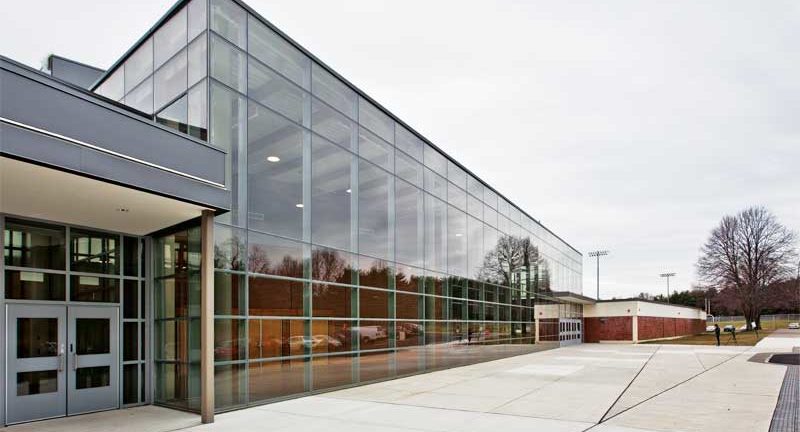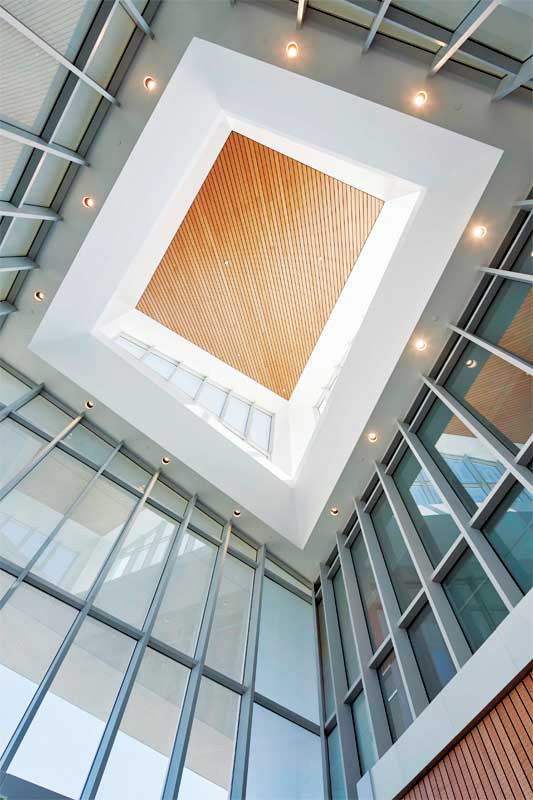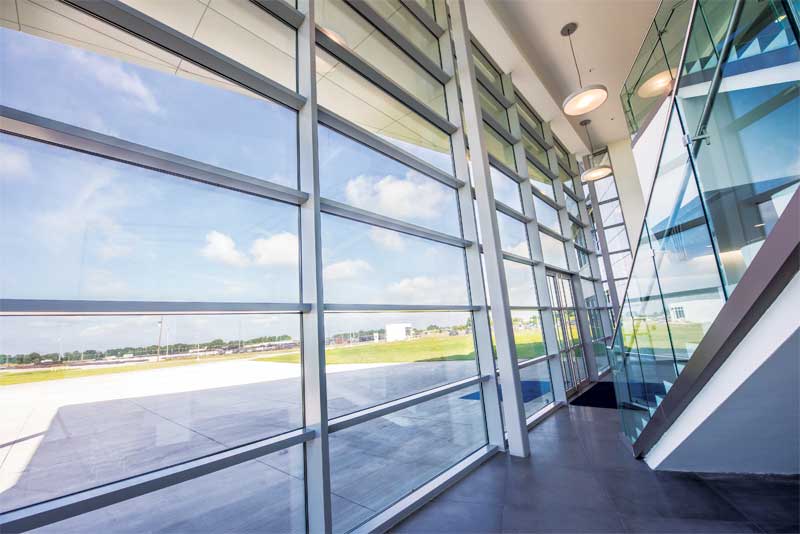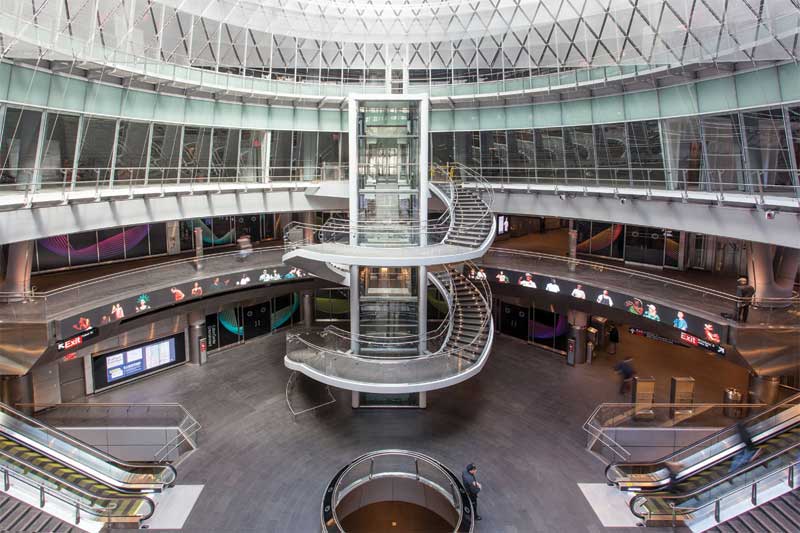Specifying steel curtain walls with enduring beauty
by Katie Daniel | February 28, 2017 11:58 am
 [1]
[1]By Chuck Knickerbocker
Each year, curtain walls continue to soar higher, form angles that are more challenging, and push the building envelope closer to total transparency. A case in point is the Toronto Transit Commission’s (TTC’s) Vaughan Metropolitan Centre Station, which is slated for completion in the suburb later this year.
To create a curved entryway pavilion that acts as a counterpoint to the vertical subway station and helps introduce light deep into its underground concourse, Arup Canada, in association with Grimshaw Architects, designed an extensive roof structure in the shape of a ‘saddle.’ It integrates with a curtain wall configured to segment around the exterior at varying heights at the two open ends of the saddle. This imaginative entryway helps create an elegant building that looks as if it houses art, not a subway line.
To enable sophisticated curtain wall assemblies like the one in Vaughan Metropolitan Centre Station, design teams are turning to framing materials that are as strong as they are versatile. Increasingly popular materials now being used for curtain wall frames include carbon and stainless steel profiles. Thanks to advanced manufacturing and fabrication techniques, they can bring form and function to curtain walls for years to come.
 [2]
[2]Modern steel frames
Carbon steel is the most commonly used type of steel for curtain wall framing. It has a Young’s modulus ÿ of approximately 207 million kPa (30 million psi), in comparison to aluminum, which is approximately 69 million kPa (10 million psi). This allows the material to support larger free spans at the podium level of buildings. Another increasingly popular option, stainless steel, can support expansive curtain wall assemblies while providing a high-end esthetic and additional protection against corrosion.
From a design standpoint, carbon and stainless steel framing members are now available to support glazing applications in lengths and shapes previously impossible with hollow-metal, hot-rolled, or welded steel frames. Fabricators can roll or laser-weld the profiles into project-specific shapes. This versatility makes it possible for design teams to capitalize on steel’s strength in a wide range of complex curtain wall assemblies, from segmented steel curtain walls to multi-story steel curtain walls with expansive free spans. Modern steel frames can also help advance curtain walls in areas with fire and life safety criteria.
While steel’s strength and enhanced flexibility are attractive to design professionals looking to push the curtain wall envelope, concerns can arise over whether steel frames can provide enduring beauty. Even the most complex and imaginative curtain wall assembly will detract from a building’s esthetic if it starts to deteriorate—earlier steel curtain wall systems had a reputation for being susceptible to corrosion, moisture intrusion, and wear.
The good news for interested design professionals is manufacturing and fabrication advances have addressed earlier problems with preserving steel’s appearance. Since these developments are relatively recent to markets in North America, it may not be immediately clear how they can protect a steel curtain wall’s esthetic. To help guide industry professionals, this article examines considerations for selecting steel curtain walls designed to stand the test of time. Where applicable, it will highlight considerations specific to stainless steel. (As with any specialty glass and framing system, product nuances vary by manufacturer. It is important to consult the supplier’s documentation for specific installation instructions, particularly for more complex steel systems, such as structural-silicone-glazed steel curtain walls.)
 [3]
[3]Moisture intrusion
Advanced steel curtain wall assemblies resolve an important performance challenge—preventing water in the glazing cavity from coming into direct contact with the steel frame. By incorporating a continuous gasket across the full width of the steel frame, they can provide sufficient protection against dynamic and static water penetration, and reduce the potential for corrosion.
For example, steel frames with continuous gasketing keep water off the tops of insulated glass (IG) units and direct it to the verticals. Installers then must ensure performance by sealing the lapped gasket joints at horizontal-to-vertical connections to prevent water intrusion to the steel back members and interior occupied spaces.
As an added benefit, these systems do not require zone damming at each glazed lite to help manage water flow within the system, as is typical with aluminum pressure plate systems. The full gasketing fabrication method without zone damming still provides a water penetration resistance of 718 Pa (15 psf), meeting ASTM E331, Standard Test Method for Water Penetration of Exterior Windows, Skylights, Doors, and Curtain Walls by Uniform Air Pressure Difference.
To ensure greater protection from corrosion once the building is completed, some steel systems employ more-conventional aluminum or stainless steel cover caps and pressure plates to retain the glass to the framing. They rely on self-sealing fasteners that penetrate the glazing, while simultaneously blocking access for water penetration. When using structural silicone glazing, sealants specific to the application are available. They hold the glass to the framing in lieu of pressure plates and covers, as is typical with captured curtain wall systems.
Installers can also place watertight weather seals around the perimeter of the framing. The seals are made to gaskets at the back of the glazing pocket. Typically, they are made to special extrusions or to perimeter details in plane with the glass instead of to the framing. By placing perimeter seals in front of the steel, the installer eliminates any chance of water contacting the material behind the seal.
Even though stainless steel has improved resistance against corrosion, many features are the same when using stainless steel for the frame gasketing. The edge seal details are similar for either material, and both can offer the same air- and water-penetration resistance.
To further simplify and standardize fabrication and installation for both materials, while still meeting the higher performance criteria of modern curtain wall construction, steel curtain wall system suppliers have developed all component parts to the point where a complete system is often available, including:
- connection detailing and hardware;
- gasketing;
- exterior pressure plates and cover caps; and
- complementary door and entry systems, as well as detailing.
Due to the full gasketing across the face of the systems at the back of the glazing pocket, some steel curtain wall systems can provide even greater protection against the elements. For example, water resistance can be as much as 25 per cent greater in an off-the-shelf steel curtain wall assembly than with a conventional extruded aluminum curtain wall. Additionally, air penetration is almost non-existent in steel curtain walls due to the full gasketing, testing to as low as 0.1 cf/sf of wall (per ASTM E283, Standard Test Method for Determining Rate of Air Leakage Through Exterior Windows, Curtain Walls, and Doors Under Specified Pressure Differences Across the Specimen, at 298.7-Pa [6.24-psf] pressure differential).
| BRIDGING FIRE AND LIFE SAFETY WITH DESIGN GOALS |
| Modern steel frames are advantageous not just for non-rated curtain wall systems, but also for fire-rated systems. In large part, this is due to advances in manufacturing techniques.
Steel fire-rated frames can be formed from tubes, instead of sheets, and shaped from coil stock in a rolling process. (This is similar to the way non-rated steel frames are fabricated, as discussed in the main article.) These fire-rated frames are more slender than the wrap-around form of traditional fire-rated ‘hollow-metal’ steel frames. They have narrow profiles, well-defined corners, and crisp edges. They can also be custom-painted or powder-coated, and can incorporate custom cover caps to match a wide array of design schemes. When these versatile steel fire-rated frames are engineered and manufactured as part of a complete fire-rated curtain wall system (where the fire-resistive glass, framing, and component parts have been designed to work together and meet the minimum fire rating for the entire system, in accordance with the National Building Code of Canada [NBC]), they can satisfy stringent fire and life safety criteria. For example, Canadian test standards that such fire-rated curtain wall systems meet include:
With exceptional fire resistance and enhanced versatility, these high-performing fire-rated curtain wall systems can help bring fire safety in line with the design intent. For example, one popular option is to specify fire-rated curtain walls with narrow steel frame profiles and custom cover caps. They allow design teams to more closely match the look of non-rated curtain wall systems, as was the case in the Fulton Center Transit Hub in New York City (shown on page 24). Grimshaw Architects, in conjunction with Arup, installed a non-rated and rated-steel curtain wall system with custom captured horizontal steel mullions to maintain a uniform look within the grand atrium’s two-level circular enclosed space. Design teams can also use the smooth, exterior surface of silicone-glazed fire-rated curtain walls to visually tie in with neighboring structural silicone glazed curtain wall systems. The system achieves a sleek, exterior appearance through a toggle retention system that becomes hidden once installed, thus eliminating the exterior pressure plate and cover cap of a conventionally captured system. Where it is desirable to install fire-rated glass walls in interior spaces with virtually uninterrupted views, design teams can select from one of the most recent options on the market—a butt-glazed fire-rated system. The fire-rated glass wall panels are installed relatively close together, with no back-up metal along the vertical edge of the glass. The top and bottom edges are installed in a fire-rated perimeter frame. The narrow, vertical glass joints are sealed, and create a continuous glass wall esthetic without vertical framing interrupting the view—a popular look that is often found in non-rated glazing applications. |
 [4]
[4]Corrosion
Steel rusts in the presence of moisture and oxygen. This is a seemingly irreconcilable performance obstacle since many curtain walls serve as the divider between interior and exterior spaces. Additionally, because steel frames do not require cladding or reinforcement to support expansive captured and non-captured curtain wall systems, properly sized frame members can act as structural elements. In many instances, they serve as the finished, exposed material, making their long-term beauty integral to the assembly’s overall look.
To help protect against rust and preserve the appearance of carbon steel members, double-sided pre-galvanization can be applied to the raw material (prior to forming and finishing). For example, the steel framing may be prefinished with liquid zinc and top-coated with a durable primer and finish colour to match virtually any design scheme. Generally, no special coatings beyond these are required to prevent corrosion.
To meet their specific project goals, design professionals can choose from various finishes, including powder coating and liquid-applied finishes specifically formulated for steel. Powder coating or liquid-applied finishes can be applied with proper cleaning or blasting, depending on the quality of the required finish. One caveat to note is typical finishes applied to aluminum, such as liquid-applied fluoropolymers, are not suitable for steel, as the chemical bond between raw materials and paint vary by material.
In some instances, design professionals may prefer steel’s strength, but desire stainless steel’s esthetic and enhanced corrosion resistance (i.e. for use with high-end storefronts or applications in coastal areas). To achieve this design intent, the exterior caps or interior back mullions can be made from stainless steel. Depending on the material thickness, suppliers can brush or bead-blast stainless steel finishes.
Finishes
Finishes are typically applied to stainless or carbon steel framing components after fabrication is complete and before installation. This eliminates potential for damage to the finish during sawing, welding, drilling, or final assembly. Additionally, it ensures minimal coatings are applied on rough edges that would otherwise be exposed during shipping to the jobsite.
Manufacturers can powder- or wet-coat steel systems using any coating suitable for architecturally exposed structural steel (AESS). While many fabricators and glaziers are familiar with liquid-applied paints common to aluminum, the downside is they can release from steel over an extended period, even with a primer. By comparison, the powder-coating process creates a tight adhesion.
During powder coating, the coating chemically reacts in the presence of heat. It produces long, densely cross-linked molecular chains that resist breakdown. The tight adhesion the reaction provides better protects against human and object impact, moisture, chemicals, ultraviolet (UV) light, and extreme weather conditions. However, as is the case with any finish material, significant surface abuse will result in wear over time.
Stainless steel profiles are generally passivated after fabrication to remove any steel particles that may form on the stainless during fabrication. Exposure to steel particles is common, as stainless steel fabrication typically takes place in the same factories where steel is processed. Passivation removes any non-stainless particles from the material surface and restores its natural oxidized finish, which may have been removed due to grinding, cutting, drilling, or welding during the fabrication process. If the stainless steel is not passivated, the carbon steel particles can form in the natural oxidation and later appear as rust flecks, calling into question whether the material is actually stainless.
Regardless of the selected finish, considering the following tips during the specification process can help ensure a quality steel frame finish:
- Specify a protective primer for carbon steel applications subject to harsh weather conditions, as well as those in areas subject to frequent use.
- Use frames with finishes designated for interior applications in interior applications only, as they do not provide adequate UV resistance for exterior applications.
- Use factory-finished frames (where the manufacturer or supplier applies the finish in a controlled, in-house environment prior to shipping to limit exposure of the steel to corrosion during transportation and installation), as opposed to a finish that is applied once the windows or curtain walls are exposed.
Galvanic action
For galvanic action to occur in steel curtain wall assemblies, the steel must be in direct contact with dissimilar metals. This is most likely to happen when design professionals specify steel curtain walls with aluminum pressure plates to achieve a specific esthetic. Fortunately, the configuration of some advanced steel curtain wall systems can help prevent aluminum pressure plates from coming into direct contact with carbon steel framing members.
For example, suppliers can use stainless steel screws to connect the aluminum pressure plates to steel back members. Stainless steel is closer to aluminum in anodic polarity, thereby reducing the potential for corrosion to occur. Steel curtain wall manufacturers and suppliers can also coat metals with a non-conductive paint or finish. This helps effectively isolate the two dissimilar materials.
An alternative method to reduce the potential for corrosion between dissimilar metals is to form the framing members from stainless steel alloys. Series 304 is typically the only stainless steel alloy used in the rolled-profile methodology (many other alloys are too brittle). Other stainless steel alloys may require significantly more fabrication time. For example, the 316 series requires slower saw and drill speeds, which increases fabrication time. As a result, a best practice is to check with fabricators prior to specifying a stainless alloy.
Before installation
The exterior walls of a building define its looks. With proper specification, advanced steel curtain walls can help design teams meet modern design demands, and provide assurance they will look beautiful for years to come. This requires careful due diligence and review of architectural drawings, specifications, approved shop drawings, and manuals well in advance of pricing and installation.
Each steel curtain wall framing system is subject to different project conditions, from its specific environment to mullion spacing and glass size requirements. As with any assembly, reviewing these details is crucial to moving forward with a design approach protecting the framing’s long-term appearance. For example, it is important to verify the amount of deflection does not compromise the strength of the steel members, causing bowing, sagging, or joint failure. This will also aid in protecting glass lites from being forced out of place.
A final step is to consult the manufacturer or supplier’s specific installation instructions. As evidenced throughout this article, advanced steel curtain wall systems have a different set of considerations than aluminum curtain wall systems in some areas. Additionally, products vary by manufacturer. Assuming standard practices may result in incorrect installation, particularly regarding air and water integrity, and risk the manufacturer’s warranty from being extended. Many manufacturers are more than willing to provide design and installation support, and aid in creating steel curtain walls that are attractive for years to come.
| FABRICATING MODERN STEEL FRAMES |
| Manufacturers use two fabrication techniques developed in Europe to create slender carbon and stainless steel frames in a wide variety of shapes. The first process is a cold-roll forming technique. With this process, manufacturers feed continuous steel coils through dies and form them into basic, closed profiles that can frame a curtain wall. Since the coils are continuous, this allows for long-length framing members.
The second option is to laser-cut long (up to 14.9 m [49 ft]) steel plates (3.8 to 38 mm [0.15 to 1.5 in.]) and laser-weld them together into a range of different shapes. Popular shapes include C, T, I, H, and L profiles, as well as custom shapes. The laser welds on the inside corners (of Ts or I-profiles, for example) are continuous and smaller As an added benefit, the process of welding bars into a single shape makes it possible for project teams to analyze and use the shapes as composites, rather than assembled members. The heat from the laser-welding process results in a full penetration weld, which acts to join the shapes as if they were hot-rolled, not assembled into the |
 [5]Chuck Knickerbocker is the curtain wall manager for Technical Glass Products (TGP), a supplier of fire-rated glass and framing systems, along with specialty architectural glazing products. With more than 35 years of curtain wall experience, he has successfully worked with numerous architects, building owners, and subcontractors from development of schematic design through installation. Knickerbocker is the chair of the Glass Association of North America (GANA) Building Envelope Contractors (BEC) Division Technical Committee. He can be contacted via e-mail at chuckk@tgpamerica.com[6].
[5]Chuck Knickerbocker is the curtain wall manager for Technical Glass Products (TGP), a supplier of fire-rated glass and framing systems, along with specialty architectural glazing products. With more than 35 years of curtain wall experience, he has successfully worked with numerous architects, building owners, and subcontractors from development of schematic design through installation. Knickerbocker is the chair of the Glass Association of North America (GANA) Building Envelope Contractors (BEC) Division Technical Committee. He can be contacted via e-mail at chuckk@tgpamerica.com[6].
- [Image]: https://www.constructioncanada.net/wp-content/uploads/2017/02/TGP_Image-4-e1488299658638.jpg
- [Image]: https://www.constructioncanada.net/wp-content/uploads/2017/02/TGP-_-Image-1.jpg
- [Image]: https://www.constructioncanada.net/wp-content/uploads/2017/02/TGP_Image-2.jpg
- [Image]: https://www.constructioncanada.net/wp-content/uploads/2017/02/Fulton.jpg
- [Image]: https://www.constructioncanada.net/wp-content/uploads/2017/02/Chuck.jpg
- chuckk@tgpamerica.com: mailto:chuckk@tgpamerica.com
Source URL: https://www.constructioncanada.net/specifying-steel-curtain-walls-with-enduring-beauty/